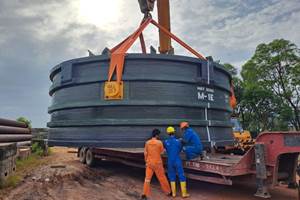SAMPE Paris event highlights composites for auto, infrastructure
Summit Paris 2016, held one day before JEC World 2016, focused on emerging and creative technologies for cars and for bridges.
SAMPE Europe held its one-day Summit Paris 2016 event at the Pullman Hotel with a close-up view of the Tour Eiffel. The event was structured with four blocks of papers focused on Automotive, Advanced Products & Engineering, Composites in Architecture and Infrastructure, and Aerospace.
Among the 13 papers was an informative presentation by Heinrich Timm, formerly a director of Audi’s Lightweight Center and currently a board member of Carbon Composites e.V. (an association of companies and research institutes that covers the composites value chain in Germany, Austria and Switzerland, founded in 2007). Timm related that his group at Audi studied the impact of mass, and how high-strength steels, aluminum and composites all played a part in creating sufficient stiffness for the automaker’s car bodies. He described how aluminum castings designed in specific shapes were employed in the A8 model in a space frame concept that provided design freedom to cut mass, when employed in concert with steel for stiffness. He emphasized that trial and error will not guide designers to the best solution, that carbon is not a replacement for metal, and that virtual simulation is a must for a multi-material concept, to take advantage of carbon fiber’s anisotropy. He described a Carbon Composites e.V. project that aims to reduce the processing cost of carbon composites by 90%, and material cost by 50%: “If we don’t reach these numbers, carbon fiber won’t be going into mainstream automotive.” Nevertheless, he cited the Audi 7-Series’ “patchwork” hybrid approach with carbon in selected areas, and the benefits of system integration. He added, “Don’t accept your accountant’s worries about material cost!” and concluded with the prediction that about 15% of a car body in carbon composite would make sense.
Roeland Coumans of CeraCarbon (Stein, The Netherlands) described a new material, called CeraCarbon, consisting of carbon fiber laminate tubes coated with a ceramic material. Since a patent is pending, specific details were few, but Coumans related that his product has already been adopted by Moto GP motorcycle racing teams for suspension elements that typically see wear and abrasion. CeraCarbon suspension elements are 75% lighter, saving 1.5 kg in unsprung weight — a huge advantage. He related that aircraft landing gear elements and helicopter blades would be promising applications.
Jan Peeters of FiberCore Europe (Rotterdam, The Netherlands) impressed the audience with no-nonsense descriptions of his company’s cost-effective and durable way to build robust composite bridges. Using a reconfigurable mold, automated methods and serial production, FiberCore has installed more than 450 structures so far in Europe, and at costs that are often less than traditional materials. His Infracore concept of stacked, Z-style composite beams eliminates the Achilles Heel of composites in bridges: interlaminar shear and subsequent delamination. He described an upcoming project involving a 100m free span in composites, which will require 50 tonnes of resin for the infusion, in one shot. FiberCore grew by 50% in 2015, thanks to its “completely new way of thinking,” says Peeters.
Valentin Koslowski of the University of Stuttgart (Stuttgart, Germany) gave a fascinating paper on a bio-based architectural concept: replicating spider cocoons with carbon and glass fiber to form novel architectural spaces. The process starts with an inflated polymer bag, with shape maintained with positive pressure. An articulated robot inside the bag places individual tows of carbon or glass against the plastic; the end effector developed by the university is able to stick the tow to the plastic without applying so much pressure that the bag breaks. The composite tows cure at ambient temperature to form arching, random fiber strands that are programmed based on the natural spider cocoon elements. When cured, the bag is removed, and the resulting graceful and interesting “room” or space is left. The group has also advanced other innovative methods of robotic placement to form “trees” or biotic elements; one of their designs will be installed this year at the Albert and Victoria Museum in London as a sun canopy.
Related Content
U.S. grant is awarded for patented SIP composites formwork system
ConTech stay-in-place (SIP) technology, made from recycled composite materials, replaces the use of reinforcing steel in the construction of flat, elevated concrete surfaces.
Read MoreSwedish parking garage to incorporate decommissioned wind blades
Architect Jonas Lloyd is working with Vattenfall to design the multistory building with a wind blade façade, targeting eco-friendly buildings and creative ways to remove blades from landfills.
Read MoreComposites end markets: Infrastructure and construction (2024)
Composites are increasingly used in applications like building facades, bridges, utility poles, wastewater treatment pipes, repair solutions and more.
Read MoreThe potential of rCF in fiber-reinforced concrete
A look at how emerging technologies for FRP concrete provide alternatives to traditionally used steel and glass fibers that are more cost-effective and address the sustainability challenge.
Read MoreRead Next
Scaling up, optimizing the flax fiber composite camper
Greenlander’s Sherpa RV cab, which is largely constructed from flax fiber/bio-epoxy sandwich panels, nears commercial production readiness and next-generation scale-up.
Read MoreUltrasonic welding for in-space manufacturing of CFRTP
Agile Ultrasonics and NASA trial robotic-compatible carbon fiber-reinforced thermoplastic ultrasonic welding technology for space structures.
Read MoreCeramic matrix composites: Faster, cheaper, higher temperature
New players proliferate, increasing CMC materials and manufacturing capacity, novel processes and automation to meet demand for higher part volumes and performance.
Read More












